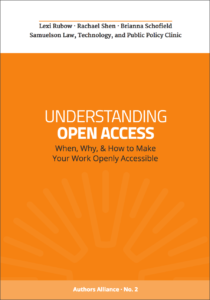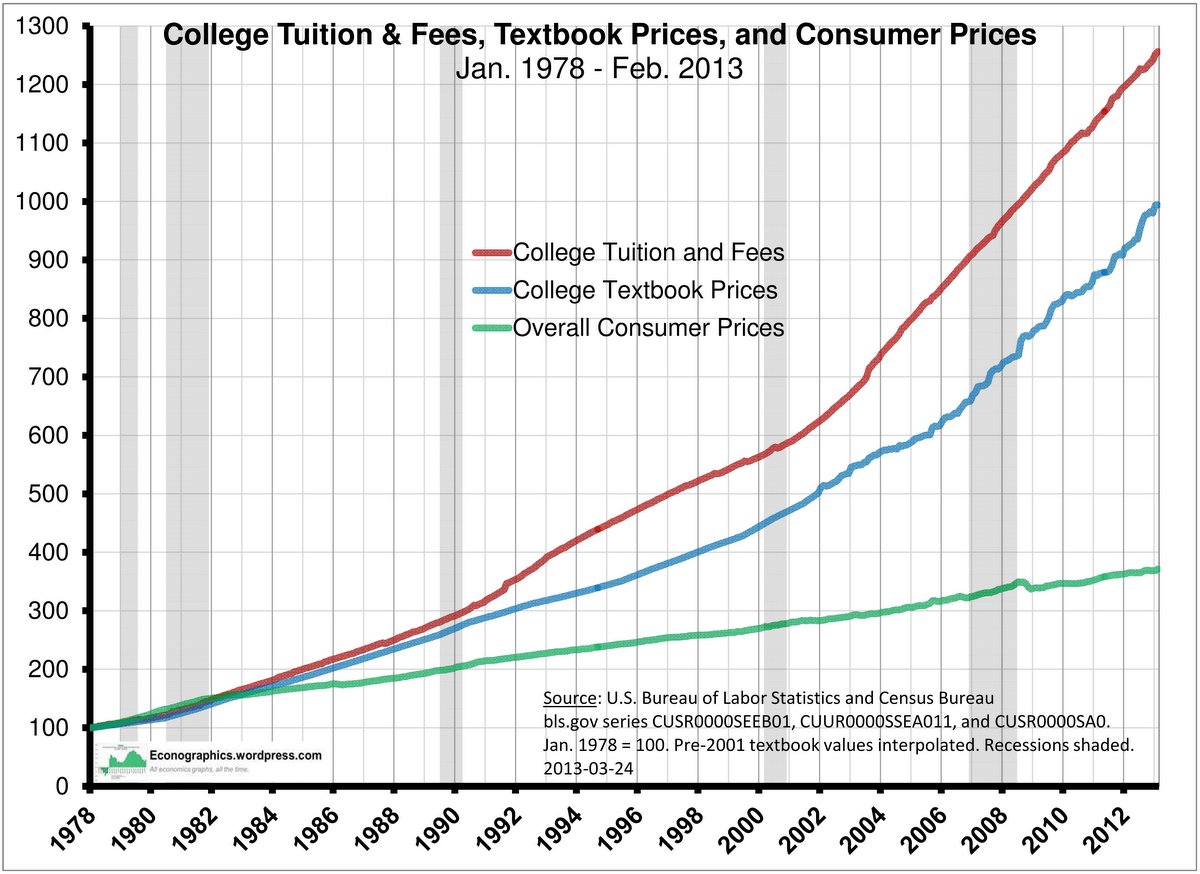by Pamela Samuelson and Molly Van Houweling, Authors Alliance Co-Founders.
Last updated Oct. 20, 2014.
- What is “open access”?
- Who is adopting open access?
- Is this just for academics?
- What are the barriers to open access for authors who want to adopt it?
- How do university-wide open access policies work?
- What do the terms “Green OA” and “Gold OA” mean?
- What is the relationship between Open Access and Authors Alliance? Is Authors Alliance only for authors who make all of their work available on open access terms? What about authors who need to sell copies of their books?
- Are there any advantages of assigning copyrights to publishers or other intermediaries?
- Where can I learn more?
What is “open access”?
Many authors are choosing to make their works available free of charge and with few, if any, restrictions on reuse. The term “open access” is commonly used to describe this practice and the movement that promotes it. Open access contrasts with more traditional models of “restricted access” publishing in which copies of works are only made available to paying customers and, in the case of libraries, their patrons.
(Back to top)
Who is adopting open access?
Choosing open access is most common among those who want to use the power of the internet to share their findings and scholarship with as broad a readership as possible. These authors want to reach people all over the world, including those who might not have access to libraries that subscribe to expensive scholarly journals. Some researchers accomplish this by posting their scholarly works on their own websites or in institutional repositories and indicating that anyone may copy and redistribute those works. This practice is consistent with the requirements of a growing number of funding agencies that demand that the research they fund be made accessible to the public. (See, for example, the NIH Public Access Policy and California’s newly-enacted Taxpayer Access to Publicly Funded Research Act.)
Open access is especially attractive to authors who are paid salaries or receive grant funding to produce research and scholarship. Such authors are less likely to rely on revenue from the sales of copies of their works to fund their research and writing. In fact, in the scholarly journal publishing context, authors do not typically receive royalties or other payments based on the sale of copies of their articles. What they receive instead are the rewards associated with impacting both fellow scholars and the public at large—rewards that can be enhanced by open access.
(Back to top)
Is this just for academics?
While the term “open access” is generally used in reference to scholarship, salaried researchers are far from the only authors attracted to the open access model. For example, the standardized open access licenses promulgated by Creative Commons (“CC”) have been adopted by writers, graphic artists, photographers, musicians, filmmakers, and all types of creators who want to see their works widely accessed, shared, and even adapted into new works. They choose from among a menu of licenses depending on whether they want to allow commercial or only non-commercial use, whether they want to allow adaptations or only verbatim copies, and whether they want to require any adaptations to be licensed under the same terms. All of the standard CC licenses require proper attribution, although CC also offers a separate legal tool called “CC0” for those who want to waive copyright altogether and opt into “no rights reserved.”
A number of other open access licensing models are available, especially for computer programs. The GNU General Purpose License (“GPL”) is one of the best known of these. GPL software can be reproduced, distributed, and adapted, so long as adapters release their source code and license it on GPL terms.
(Back to top)
What are the barriers to open access for authors who want to adopt it?
Author-initiated open access—even via self-archiving on an author’s own website—is inconsistent with the once-prevalent practice of assigning copyrights to publishers or granting publishers exclusive copyright licenses. Under the terms of such agreements, publishers can (and sometimes do) object when authors distribute their own works on open access terms. Authors committed to open access need to retain the rights to distribute their own work and authorize others to reuse it.
This is more challenging for some authors than for others. Scholars who write about contemporary art, for example, must often clear rights to reproduce images in articles commenting on these copyrighted creations (although some use is permitted under copyright’s fair use doctrine). It may be more difficult to negotiate permission to include images in open access works than in a limited print run of paper journals.
For other authors, the prestige of publishing an article in a leading peer-reviewed journal whose publisher insists on assignments of copyright may be a strong incentive to choose not to make works available on an open access basis. This is especially of concern to junior faculty whose tenure applications may depend on a publication record in top peer-reviewed proprietary journals, and to scholars in fields without established open access outlets.
These obstacles should fall, however, as open access journals establish their own reputations and proliferate across disciplines, as existing journals adopt more open practices, and as senior scholars signal the value of maximizing scholarly dissemination. Options are also increasing for authors who want to apply open access principles to books as well as articles. (See, for example, the new initiative at UC Press.) The Authors Alliance hopes to contribute to ongoing efforts to establish new models of dissemination that work for every author who wants to use open access to be more widely read.
(Back to top)
How do university-wide open access policies work?
When faculty members assign their copyrights to publishers, their universities (which often paid for the costs of developing the materials in the first place) end up having to pay high prices to purchase back the works of their own faculty. And faculty members who have assigned copyrights cannot make their own scholarship publicly available or authorize others to reuse it.
To overcome these problems and improve the flow of scholarly communication, many university faculties have expressed their collective commitments to open access. They have adopted policies under which faculty members agree to deposit their articles into institutional repositories and to grant the permission necessary for those repositories to make the articles available for public access and reuse.
When faculty authors at these institutions insist on instead granting exclusive rights to publishers, they must seek waivers of their open access policies. Although most such policies grant waivers liberally, they nonetheless change the default practice away from exclusive publisher rights under restrictive terms and toward open access. Evidence so far suggests that waiver requests are rare and that many scholarly journal publishing agreements now reserve to authors the rights necessary to make at least the author’s final version (before the publishers’ edits and formatting) available on open access terms.
(Back to top)
What do the terms “Green OA” and “Gold OA” mean?
Both authors and publishers can implement open access. When authors make their own work available—whether on their personal websites, their institutional repositories, or on third-party repositories like arXiv.org—the practice is commonly called “Green Open Access.”
Increasingly, publishers themselves are adopting open access models. When a publisher is the party making open access works available to the public, the practice is called “Gold Open Access.”
(Back to top)
What is the relationship between Open Access and Authors Alliance? Is Authors Alliance only for authors who make all of their work available on open access terms? What about authors who need to sell copies of their books?
Helping authors make their works available on open access terms is consistent with the mission of Authors Alliance: assisting and representing authors who want to disseminate knowledge and products of the imagination broadly. But open access is not the only way for authors to promote the broad dissemination of their works, and Authors Alliance will help authors pursuing a wide range of approaches.
For example, many authors assign their copyrights to commercial publishers in order to earn advances and royalties, but years later are earning nothing because their books are out of print. Authors Alliance is developing educational resources and tools that will help such authors reclaim their rights (by exercising options in their original contracts or renegotiating with their publishers). Some authors may want to reclaim copyrights in order to put the works in the public domain or make them available through open access licensing. Other authors will want to reclaim rights in order to self-publish or make new arrangements with publishers so their out-of-print works avoid digital oblivion. Bringing a book back into print or making it newly available in digital form makes it more accessible than before and therefore contributes to our mission. And our advice on rights reversions will be useful to both those who choose open access and those who opt for more proprietary alternatives.
(Back to top)
Are there any advantages of assigning copyrights to publishers or other intermediaries?
Authors who rely for their livelihoods on advances and royalties from publishers who sell copies of their books or articles often assign copyrights (or grant exclusive licenses) to those publishers in order to secure both publication and compensation. In addition to needing compensation in order to make their livings, these authors may prefer to have their publishers deal with copyright registration, detecting infringement and sending cease and desist letters, and other copyright details about which the publisher is likely to have more expertise than the individual author (although many authors in this situation have agents to help them navigate the process).
Note, however, that these preferences may be time-limited, relevant only for the commercial life of an author’s books and articles. Most works stop earning money long before their copyrights expire. At this point publishers may lose interest while authors will want to find ways to ensure that their intellectual legacies live on. Authors Alliance will be developing resources to help all authors better understand the consequences of copyright assignments and how they might be adjusted them over time.
(Back to top)
Where can I learn more?
Researchers committed to open access have developed refined definitions of it and articulated policies supporting it, including the Berlin Declaration on Open Access to Knowledge in the Sciences and Humanities, the Bethesda Statement on Open Access Publishing, and the Budapest Open Access Initiative.
These definitions are broad enough to encompass a range of different specific practices for sharing works of authorship and granting permission to reuse them. It can therefore be useful to think about open access along a continuum, asking “how open is it?” using this guide produced by the Scholarly Publishing and Academic Resources Coalition and Public Library of Science.
Other excellent sources of information about Open Access include:
(Back to top)





